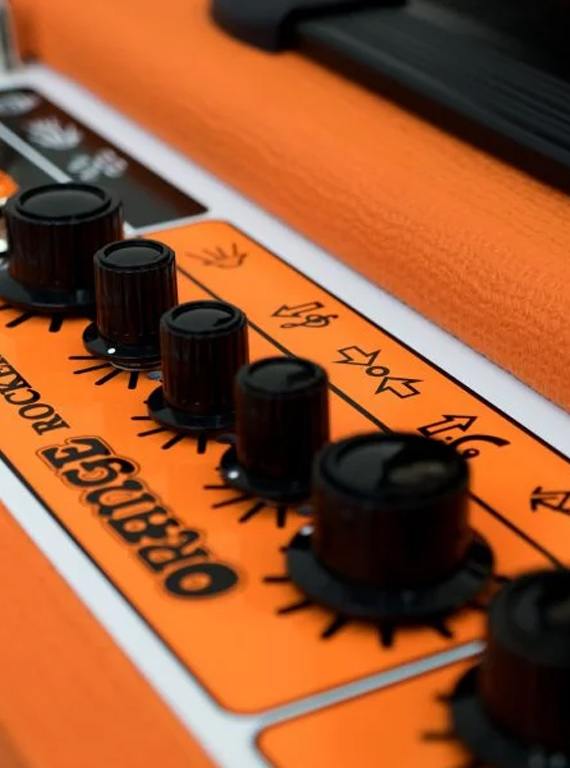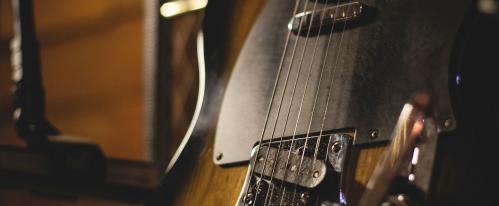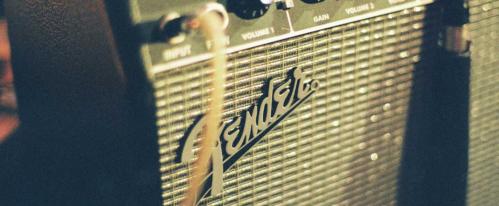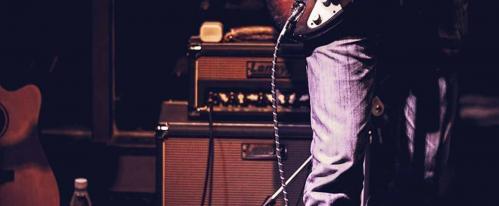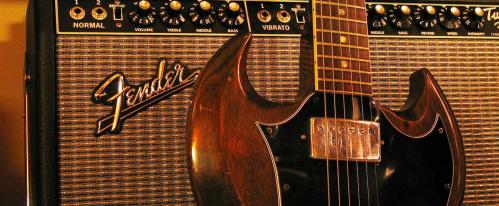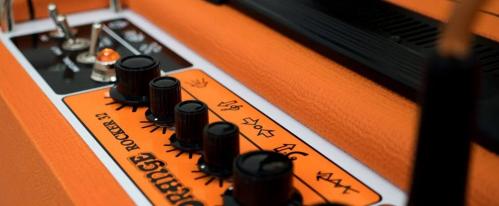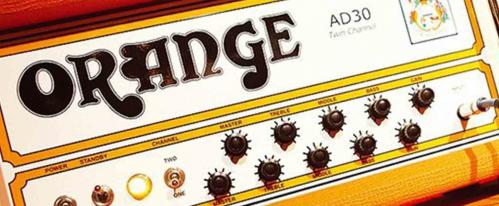See What The Guitarist Magazine Verdict Was in their ORANGE ROCKER 30 COMBO & ROCKER 30 HEAD REVIEW
Before we begin, it's worth noting that the Orange Rocker 30 Combo and Orange Rocker 30 head are no longer available, but we now have the Orange Rocker 15 and Orange Rocker 32 amplifiers in stock. Check out a full run down of the New Orange Rocker 15 & Rocker 32 Amplifiers on our blog and watch the demo below.
ORANGE ROCKER 30 COMBO & ROCKER 30 HEAD REVIEW FROM GUITARIST MAGAZINE
This article originally appeared in Guitarist Magazine July 2006.
The sound of the summer has a citris flavour with a kick, as we bite into two new Oranges that rock" Review by Chris Vinnicombe, Guitarist Magazine. Anyone who attends one of this year’s Summer festivals, and remains sober enough to be in full possesion of their faculties, is likely to notice a copious amount of Orange gear amid the backlines of the rich and famous – and with good reason.
Whether it’s the classic British tonality of the popular AD series, or Custom shop uber-heads such as the Retro 50, Oranges amplifiers have confirmed devotees amongst the highest echelons of rock’s elite. Back in issue 253 we got our hands on the first amplifiers in the new Rockerverb series – a brand new breed of twin channel beast designed to compete with the big-league heavy rock heads in the scorching distortion stakes while retaining tonal characteristics that are unmistakably Orange.
Yet while the powerful Rockerverb 50 and Rockerverb 100 were impressive, many players will be interested in the real-world benefits of a pair of more manageable 30-watt additions to the range. The ‘verb-less Rocker 30 is a stripped-down 30-watt amplifier, powered by a pair of EL34 power valves running in a Class A, and available in head and 1 X 12 configurations.
OMEC tells us that the Electro-Harmonix 6CA7 will soon replace the stock EL34 as their power valve of choice because their designers believe them to be the finest EL34 variants on the market. While you might reasonably expect a pair of these valves to generate 50-60 watts in class AB, as they are operating in Class A, this is limited to around 30.
The Rocker 30s feature the same transformers as those used in the AD30TC twin channel headand combo, although most similarities between the models end here. One fairly fundamental difference is the presence of solid-state, rather than valve, rectification which should contribute to a noticeably less compressed and “spongy” attack.
Players have been crying out for a 30-watt 1 X 12 Orange for a long time now, with many seeing it as the perfect power/portability compromise for regular gigging.
THE ORANGE ROCKER 15 SERIES AVAILABLE TODAY
The range of Orange Rocker 15 amplifiers allow you to get that classic Rocker sound at lower volumes.
Channels
Orange’s other 30-watt combos are 2 X 12s, and while they sound fantastic, we’ve learnt the hard way that your back won’t thank you for carrying one up a narrow staircase on the “toilet” circuit. The combo has been designed to supersede the now discontinued AD15 which offered just one channel and around 15 watts from a pair of EL84s, so this is a fairly big step up in specification terms.
The Rocker 30’s Natural channel us controlled by just one volume pot and features a single-stage preamp incapable of preamp distortion, so any break up on this channel is pure power amp drive.
The Dirty channel, meanwhile, is a scaled-down version of the lead channel on the bigger Rockerverb amplifiers. Featuring three gain stages rather than four, it should allow for an expanded low-gain vocabulary from a channel that gets very dirty indeed. While the Natural channel is about as straightforward as valve amplification gets, the Dirty channel benefits from the relative luxury of individual channel volume and gain controls, along with three-band EQ.
Cosmetically, both the Rocker 30 combo and head are standard Orange fare – although in common with the bigger Rockerverb Models, new three-way toggle power switches include a middle standby setting to save space on the front panels. This leaves room for more ornamental features such as quirky graphical representations of each control on the panel. This contributes to the unmistakable funk vibe and hark back to the days of fists and mountains denoting function.
Orange Rocker 32 Amplifiers Available today
Controls & Features
Externally, the head is identically proportioned to the AD-series models and 40mm shallower than the Rockerverb heads. On the inside, both head and combos share the same chassis innards and high-quality printed circuit boards.
In common with the other Orange combos in current production, the Rocker 30’s control panel is situated vintage-style in a recess at the rear top edge of the cabinet, so the chassis has to be mounted in such a way that the power valves sit horizontally – rather than vertically as they do in the head. This means that in order to perform a valve change, in the case of the combo, the whole chassis has to be unscrewed and lifted out from the cabinet.
With the head, things are a little simpler as the procedure only involves removal of the protective metal grille around the back in order to gain access to the valves.
There is one feature common to both that makes maintenance less of a headache: due to the nature of the Class A circuit, both head and combo are self biasing. Along with the Rocker 30 head and combo, you may have noticed amongst the visual feast on these pages the new Orange1 X 12 extension cabinet, the PPC112.
Designed with the same footprint as the combo, with the intention of giving more onstage oomph, it also makes for a cute mini-stack when partnered with the head. Like all new Orange cabinets, it features rugged 18mm birch ply close-back construction – thankfully with no MDF in the equation.
Orange Rockerverb 50 MKIII Amps Available today
Sounds & Tonal Options
The beauty of a 30-watt power stage is that you can really rev the amp up and get those power valves cooking without being completely deafened, but there should be enough in reserve to preserve a useable clean tone at stage volumes. Beginning with the exceptionally well-balanced Natural channel, one of the most striking characteristics of the Rocker 30 in both head and combo configurations is the way in which the simplicity of the circuit preserves the identity of your instrument. Rather than imprinting its characteristics on your sound in a stifling manner, the Natural channel works as an instrument in its own right – responding to and enhancing the voice of both guitar and player.
The single stage preamp translates into an abdundance of clean headroom, and we found that once the natural volume was wound up anywhere 11 o’ clock and beyond, we were rewarded with a lush, three-dimensional sparkling clean tone at stage volume with a hint of an edge - oozing with the fruity mid-range warmth that characterizes the classic Orange sound. The onset of actual drive will be pickup dependent, but if you can’t dial the in the require amount of break-up at the volume level that you want, it’s simple enough to solve this with judicious use of the guitar’s volume control or an additional stompbox boost such as an MXR Microamp. Compared to the EL84-driven AD series amplifiers, the clean channel doesn’t possess quite as much glassy chime and detail, but even through the combo’s single Vintage 30 speaker, the Rocker 30’s El34s ensure a firmer, more focused bass response. And if this isn’t quite enough for you, the closed-back PPC112 extension cabinet increases the scale and projection considerably.
Flip to the Dirty channel and there’s clearly a lot more flexibility available. Cranking up the gain, we move from chiming sixties pop, through Stonesy R&B raunch, heading into bluesy classic rock grind and aggressive alternative territory, until the final quarter of the gain control’s range, when the Rocker 30 grows devil horns. At all levels there is a consistent musicality. Rather than losing definition or becoming a fizzy mush, the Rocker 30 roars with an organic and dynamic high gain voice that is world class, particularly in combination with a PAF-style bride humbucker.
The tonal range on this amplifier is phenomenal, particularly in a studio environment. For recording the Rocker 30 can cope as convincingly with country as it does with bone-crushing riffs, and the combo in particular records superbly, with the open back cabinet contributing much better bass response than one might expect – even when close-mic’d with just a single Shure SM57. Plugging the Rocker 30 head into the PPC112 we encountered very similar high-quality sonic performance, although the PPC112’s closed back cab translates into an even tighter bottom end at higher gain settings, and a laser-like directionality in contrast to the combo’s more even sound dispersal.
Orange Rockerverb 100 MKIII Options Available Today
The verdict
The Rocker 30 combo could be nigh on perfect for players who gig and record regularly but need a compact, powerful set-up that can travel comfortably on a car seat. As the combo also features multiple speaker outputs, the sound can be reinforced on big stages with the PPC112 or any cabinet that suits your tastes. However, if cabinet swapping is one of the ways in which you sculpt your tone then the Rocker 30 head is probably the most practical option. It’s also no slouch when driving a 4X12 – the sound is simply huge.
Inevitably some players will desire more control over their clean sounds that is afforded by either the head or combo, but don’t know a simple circuit like this until you have experienced just how dynamic as can be at first hand.
Far from merely covering a great deal of territory with efficiency, the Rocker 30s excel across the whole tonal range of both channels. Perhaps if you only need two great sounds, and don’t require quite the levels of high gain that the Rockers can muster in the last quarter of the Dirty channel’s drive control, prospective Orange converts might find that the most suitable 30-watter is the AD30TC.
That said, this is a cheaper more versatile, and in case of the combo, a much more compact amp that we’d feel bringing along to any gig or session.

